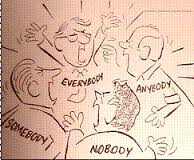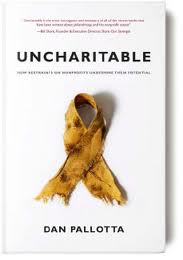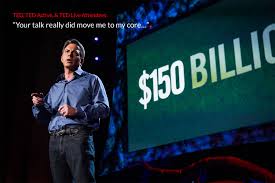5 Things Non Profits can Strengthen in 2014
By Dani Robbins
Re-published with permission from nonprofit evolution blog
 As I’m sure you aware by now, I like to reflect back on things that have occurred and create a plan to avoid their reoccurrence. As such, I’ve been thinking about things our field can do to be stronger.
As I’m sure you aware by now, I like to reflect back on things that have occurred and create a plan to avoid their reoccurrence. As such, I’ve been thinking about things our field can do to be stronger.
1. Build Better Boards
You’ve seen me write it before and it’s still true, everything flows from the board. Weak boards hire weak leaders who manage weak agencies. Sometimes it goes the other way, weak boards hire strong leaders who do whatever they want because the board is asleep at the wheel. Neither contributes to effectively governed agencies.
Strong boards hire strong leaders who build strong agencies.
For more information on building strong boards, please see previous posts on board development.
2. Create Succession Plans
Agencies that have great leaders need to plan for that leader’s transition as much as agencies with weak leaders. In fact, and among other things, one of the signs of a great leader is the strength of the agency once they’re gone.
Whether your exec gets fired, wins the lottery and moves to Jamaica, or retires after decades of excellent service, your board will need a plan to hire a new leader.
The Anne E. Casey Foundation’s Building Leaderful Organizations and the Federal Reserve Bank of Kansas City’s Nonprofit Executive Succession Planning Toolkit, offer a comprehensive look at planning. Each may be much broader than you need, but both can help you figure out what you need.
3. Build Capacity
Most agencies and most leaders, even and especially the ones that are great, can continue to build their capacity. Whether you have experienced tremendous growth, have a new leader, have downsized and now want to rebuild or if you just want to increase your strength, capacity building is the way to go.
Some larger national organizations have proprietary capacity building tools. If you are a part of a national organization, ask if such a thing has been created. If it has, use it. If it hasn’t, suggest it is.
For those of you who are standing alone, The Marguerite Casey Foundation’s Organizational Capacity Assessment tool is the best and most comprehensive I have seen. “It is a self-assessment instrument that helps nonprofits identify capacity strengths and challenges and establish capacity building goals. It is primarily a diagnostic and learning tool” that was designed to help agencies serving low income communities. Even if your agency has nothing to do with that community, this tool can help your agency be stronger.
4. Consider Mergers
There are lots and lots of organizations out there, some doing very similar work with very similar values. If your agency is struggling, is strong or you have a leadership transition, it might be a good time for your board to consider merging with another organization. The decision may be no, but it is an option worth putting on the table.
Again, some larger national organizations have merger tools. If you are a part of a national organization, ask if such a thing has been created. If it has, use it. If it hasn’t, suggest it is.
For those of you who are standing alone, I encourage you to reach out to your local community foundation or local nonprofit resource center for assistance. Here are a few links for your consideration:
Bridgespan’s Nonprofit M&A: More Than a Tool for Tough Times
Wilder Research’s What do we know about nonprofit mergers
And from the Nonprofit Finance Fund, a report with the same title What do we know about nonprofit mergers.
The larger our field grows, the more we will compete for limited resources. Can we be stronger together?
5 Get Better at Communicating with Donors
I am consistently surprised by the way some non profits communicate with their donors, or don’t, as the case may be. Here are some questions for you to assess your donor communication practices:
- Do donors receive a formal thank you note, on letterhead, that includes the amount of their gift within 48 hours of your receipt of their gift, regardless of the gift amount?
- Does it include the appropriate IRS language?
- Does someone call to say thank you to your largest donors?
- Does your Exec or a member of your board call those donors periodically to update them on the agency’s activities?
- Do you have a gift acceptance policy?
- Do you have a development plan?
If the answers is no to any of these questions, that is a great place to ramp up your practices.
For more information on resource development, please see previous development posts and Donor Dreams, for which I also blog.
The non profits in my community and communities across the country and the world are moving the needle on the issues they exist to impact. With on-going assessment, the implementation of best practices and constantly striving to be better and do better we can continue to make our world better.
How do you think we can best strengthen our field? As always, I welcome your insight, feedback and experience. Please share your ideas or suggestions for blog topics and consider hitting the follow button to enter your email. A rising tide raises all boats.


 Sometimes you just got nothing. It is late at night, and I have to catch a plane in the early morning. If there is going to be a Tuesday morning DonorDreams blog, then it has to happen right now. Sigh … sometimes you just got nothing! So, during times like this, I look for real experiences to share. So, I thought I’d share a conversation I had last week with a fundraising professional in New Mexico.
Sometimes you just got nothing. It is late at night, and I have to catch a plane in the early morning. If there is going to be a Tuesday morning DonorDreams blog, then it has to happen right now. Sigh … sometimes you just got nothing! So, during times like this, I look for real experiences to share. So, I thought I’d share a conversation I had last week with a fundraising professional in New Mexico.







 Over the last few months, I’ve found myself doing a lot of boardroom trainings on the subject of “Board Roles & Responsibilities“. When facilitating this training, there are two different slides talking about the board’s collective responsibilities and the other illustrates individual board members’ responsibilities. Listed on both slides at the top of the list is the responsibility of “asking questions“.
Over the last few months, I’ve found myself doing a lot of boardroom trainings on the subject of “Board Roles & Responsibilities“. When facilitating this training, there are two different slides talking about the board’s collective responsibilities and the other illustrates individual board members’ responsibilities. Listed on both slides at the top of the list is the responsibility of “asking questions“. Of course, we aren’t talking about asking questions that lend themselves to micro-management of staff. Here are just a few important questions that good boards ask:
Of course, we aren’t talking about asking questions that lend themselves to micro-management of staff. Here are just a few important questions that good boards ask: I tried to picture what a non-profit board might look like if it didn’t ask questions, and these words all came to mind:
I tried to picture what a non-profit board might look like if it didn’t ask questions, and these words all came to mind: These steps are pretty obvious and easy to follow. Because of the growing popularity of podcasts, it is often included in various software publishing wizards. You can also utilize tools like
These steps are pretty obvious and easy to follow. Because of the growing popularity of podcasts, it is often included in various software publishing wizards. You can also utilize tools like  “Grab a piece of paper. Make your best paper airplane.”
“Grab a piece of paper. Make your best paper airplane.” Often in these sessions, after one or two unsuccessful flights I see the “pilot” start adjusting the paper plane: a different fold there, a bending of the wings, sharper folds at the point… When I see this, I react —“Whoa!” What are you doing?”
Often in these sessions, after one or two unsuccessful flights I see the “pilot” start adjusting the paper plane: a different fold there, a bending of the wings, sharper folds at the point… When I see this, I react —“Whoa!” What are you doing?” On Tuesday evening I found myself sitting in front of a group of board volunteers as well as prospects who were contemplating joining the board. What started off as a routine training about basic board roles and responsibilities morphed into a discussion about what makes an exceptional board.
On Tuesday evening I found myself sitting in front of a group of board volunteers as well as prospects who were contemplating joining the board. What started off as a routine training about basic board roles and responsibilities morphed into a discussion about what makes an exceptional board. Politics — and non-profit fundraising — make strange bed fellows. Most non-profits look for donosr and sponsors. At some point, there will be a conflict between the mission of the non-profit and the reputation (earned or unfair) of the potential sponsor. Some donors and sponsors will be better for your mission than others. A Gift Acceptance Policy can help you determine what’s best for your organization.
Politics — and non-profit fundraising — make strange bed fellows. Most non-profits look for donosr and sponsors. At some point, there will be a conflict between the mission of the non-profit and the reputation (earned or unfair) of the potential sponsor. Some donors and sponsors will be better for your mission than others. A Gift Acceptance Policy can help you determine what’s best for your organization. Of course, my brain immediately went to the possibility of a billboard with two scantily clad waitresses in low cut very tight Boy & Girls Clubs tee-shirts. (Note: Boys & Girls Clubs, among many other amazing and life changing programs, have self esteem programs for young women as well as a similar program for boys teaching them what it means to be a man.)
Of course, my brain immediately went to the possibility of a billboard with two scantily clad waitresses in low cut very tight Boy & Girls Clubs tee-shirts. (Note: Boys & Girls Clubs, among many other amazing and life changing programs, have self esteem programs for young women as well as a similar program for boys teaching them what it means to be a man.) BGCA encourages its local Club leadership to talk about such things, and Clubs across the country are better for it. Since I opened my consulting firm, I have found that this to be the exception, not the rule.
BGCA encourages its local Club leadership to talk about such things, and Clubs across the country are better for it. Since I opened my consulting firm, I have found that this to be the exception, not the rule.